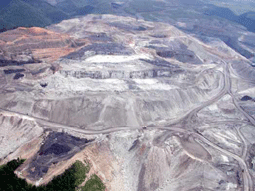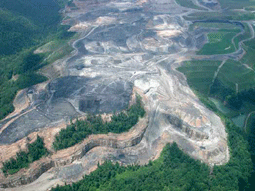Lost Mountain
Air Date: Week of February 17, 2006

Mountaintop removal in southern West Virginia. (Vivian Stockman/OVEC)
Author Erik Reece chronicles a year in the life of a mountain, destroyed by mountaintop removal strip mining. Reece tells Living on Earth host Jeff Young that the price we pay for inexpensive electricity powered by coal is offset by the cost of environmental degradation and injury to the lives of people who live and work in Appalachian coal country.
Transcript
YOUNG: It’s Living on Earth. I’m Jeff Young. When we flip on lights or a radio, most of us give little thought to what powers them. In the US there’s about a 50-50 chance the power comes from coal – coal generates roughly half the country’s electricity. And Erik Reece has been giving a lot of thought to where all that coal comes from.
Reece grew up in Kentucky, where he’s watched the Appalachian landscape radically change as mountains are removed to mine coal. In particular, Reece watched one mountain – the aptly named Lost Mountain in eastern Kentucky. It gave the title to his book, “Lost Mountain: A Year in the Vanishing Wilderness.”
Erik, Welcome to Living on Earth.
REECE: Thanks. Thanks for having me.
YOUNG: Most people who are not from that area hear coal mining and they think of a hole down in the earth, underground mining. But this, what you’re writing about, mountaintop removal, this is different, right?

Mountaintop removal in southern West Virginia. (Vivian Stockman/OVEC)
And if you think about an Appalachian mountain as a layer cake, you have thick seams of sandstone and very narrow seams of coal. And so they will blast the sandstone and then bulldoze that down into the valleys below, burying thousands of miles of streams and polluting thousands of more miles of streams, until they get down to the coal seam.
YOUNG: Tell me about Lost Mountain as it was before it was truly lost, when you first visited, first started walking its slopes. What is this place like?
REECE: Well, the thing about central Appalachia is it’s the most diverse ecosystem in North America. There’s 70 species of trees, 250 species of songbirds, there’s deer, there’s elk, there’s foxes, there’s wild turkey, grouse – I mean, it’s just a teaming watershed. And that’s what I found when I first got there: a very intact, forested watershed, with very clean water.
And I would drive my truck up an old logging road to the top of it and park and hike around. And then it got to the point where there really wasn’t any top to drive up to, and so I would just hike around the streams and the flanks and just sort of watch firsthand as this 300-million-year-old mountain was taken apart in one year.
YOUNG: I’d like you to read a little of your description from, I guess this is fairly early in the mining process. This falls on page 31, if you don’t mind reading that for us.
REECE: Right.
[READING]

Author Erik Reece (Photo: © Mary Bolin-Reece)
Stumps line the road. Down below, all of the ground cover and topsoil has been churned under by the eleven bulldozers. Nothing but mud, rock, and fallen trees remain. I park my truck out of sight of the workers below and sit down on one of the stumps. “Scalped” is the word that keeps repeating itself in my notebook. This mountain has been scalped.
YOUNG: Hmm. So, the trees here, they don’t even necessarily go to good use, do they?
REECE: No. Usually the coal operators are so ready to get to the coal they don’t even want to bother doing the logging. They just go straight for the seams.
YOUNG: So if you were to visit now, what does Lost Mountain look like now?
REECE: Well, it’s flat. It is a quote-unquote “pasture” now. They have gone in and hydro-seeded it with an exotic grass called lespedeza that the wildlife won’t even eat. And this is one of the real problems with quote-unquote “reclamation.” These companies do the bare minimum under the law to reclaim a site, and that usually means just spraying these grasses. And so where you used to have a forest that would hold back erosion and hold back flooding, now you have just these huge valley-fills.
YOUNG: You spent a lot of time with people who are fighting this, who are trying to organize. You also heard a lot from people who are closely tied to this industry who depend on it. And from that side of the argument, something that I guess you heard a lot of was, well, what good are these mountains anyway, if we’re not mining them?
REECE: Right.
YOUNG: Is that a prevailing attitude there? Minority attitude? What do you think?
REECE: I think it’s a minority attitude, but I think it’s one of those things, you know, when you’ve lived in a place all your life, sometimes you don’t see it? You don’t see the beauty of it. So I think some people just feel like the mountains are in some sense in their way. And that’s sort of a depressing thing to come across when you realize how biologically diverse these mountains really are.
And then there’s this other idea that – somebody was holding up a sign at a coal rally that said, “If it can’t be grown, it must be mined.” And, you know, I asked myself, well, what do they think is going on up there if a forest isn’t growing? And if it isn’t providing amazing habitat for wildlife? And if it isn’t purifying the water in a natural way for the people living down below? So I think there’s kind of a disconnect where people don’t understand that a healthy forest is directly connected to human health.
YOUNG: Now, part of what you’re addressing here clearly is this notion that coal is cheap energy, which is the strong selling point for coal. We can afford it. It’s why half of our electricity, more or less, comes from coal. But I guess the point you’re getting at here is that it’s not so much cheap energy as incompletely priced; that the full price is just shuffled off. Why is it so easily ignored, do you think?

Mountaintop removal/valley fill coal mining in southern West Virginia. (Vivian Stockman/OVEC)
YOUNG: So how do you propose that we bring those externalized, those ignored costs, back into the equation for coal?
REECE: I think the easiest thing would probably be a carbon tax that would actually be a tax on the use of carbon. I think another thing would be to raise the severance tax on the coal so that much more money would be returned to the region to really help these people get better jobs, repair their homes, repair their roads.
YOUNG: And then if that happens, and if mining decreases, moves elsewhere, what becomes of eastern Kentucky’s people and economy?
REECE: My feeling about this is that if we really raised the severance tax to an appropriate level, we could have something akin to a New Deal for Appalachia, where we could have a major reforestation initiative. There are hundreds of thousands of mine sites that are sitting empty, and the technology exists to reforest these mine sites. And if we did that, with the trees that were there, the hardwood trees, we could have a whole generation of foresters, of wood products industries, that would be a real sustainable clean economy for the region. That’s my hope.
YOUNG: You quote Aldo Leopold in here. He’s the great naturalist and writer who encouraged us to think like a mountain. He said something about getting an ecological education. Is that what you got here?
REECE: Yeah. And he goes on to say, to get an ecological education is to learn that you live in a world of wounds. And we do. We do live in a world of wounds. The land is dying all around us. But one other thing Leopold said that I take inspiration from is that if you – that people won’t destroy what they love. And if through writing, and through other things, we can sort of encourage people to develop affection for these landscapes, then maybe we’ll stop the destruction.
YOUNG: Erik Reece teaches at the University of Kentucky and is the author of “Lost Mountain: A Year in the Vanishing Wilderness.” Erik, thanks very much for talking with me.
REECE: Alright. Thanks for having me.
Links
“Lost Mountain – A Year in the Vanishing Wilderness” by Erik Reece
Energy Information Administration
Orion article “Moving Mountains” (Jan./Feb. 2006) by Erik Reece
Living on Earth wants to hear from you!
Living on Earth
62 Calef Highway, Suite 212
Lee, NH 03861
Telephone: 617-287-4121
E-mail: comments@loe.org
Newsletter [Click here]
Donate to Living on Earth!
Living on Earth is an independent media program and relies entirely on contributions from listeners and institutions supporting public service. Please donate now to preserve an independent environmental voice.
NewsletterLiving on Earth offers a weekly delivery of the show's rundown to your mailbox. Sign up for our newsletter today!
 Sailors For The Sea: Be the change you want to sea.
Sailors For The Sea: Be the change you want to sea.
 The Grantham Foundation for the Protection of the Environment: Committed to protecting and improving the health of the global environment.
The Grantham Foundation for the Protection of the Environment: Committed to protecting and improving the health of the global environment.
 Contribute to Living on Earth and receive, as our gift to you, an archival print of one of Mark Seth Lender's extraordinary wildlife photographs. Follow the link to see Mark's current collection of photographs.
Contribute to Living on Earth and receive, as our gift to you, an archival print of one of Mark Seth Lender's extraordinary wildlife photographs. Follow the link to see Mark's current collection of photographs.
 Buy a signed copy of Mark Seth Lender's book Smeagull the Seagull & support Living on Earth
Buy a signed copy of Mark Seth Lender's book Smeagull the Seagull & support Living on Earth

